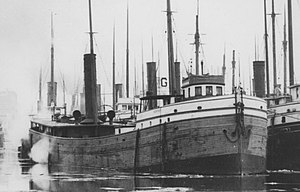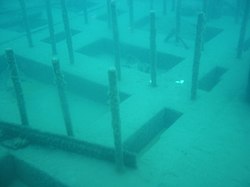SS Hesper

| |
| History | |
|---|---|
| Namesake | Hesperus, the evening star |
| Builder | Ship Owners Dry Dock Company, Cleveland, Ohio |
| Launched | June 28, 1890 |
| Fate | Sank, 4 May 1905 |
| Notes | [1] |
| General characteristics | |
| Displacement | 1540 long tons (1560 metric tons) |
| Length | 250 ft (76.2 m) |
| Beam | 41.6 ft (12.7 m) |
| Draught | 20.2 ft (6.2 m) |
| Propulsion | Vertical triple-expansion reciprocating steam engine, 825 horsepower |
| Complement | Captain E.H. Heaton and a crew of 15 |
Hesper Shipwreck Site | |
 A section of several long bolts on the ceiling, presumably used to mount the engine. | |
| Nearest city | Silver Bay, Minnesota, USA |
| Coordinates | 47°16′17″N 91°16′18″W / 47.27139°N 91.27167°W |
| Built | 1890 |
| Architect | Radcliffe, William H.; Shipowners Drydock Company |
| MPS | Minnesota's Lake Superior Shipwrecks MPS |
| NRHP reference No. | 94000343 [2] |
| Added to NRHP | April 14, 1994 |
Hesper was a bulk-freighter steamship that was used to tow schooner-barges on the Great Lakes. She sank in Lake Superior off Silver Bay, Minnesota, in a late-spring snowstorm in 1905. The remains of the ship are listed on the National Register of Historic Places.
Hesper was a wooden-hulled, single-screw, triple-masted, cargo ship built by the Bradley Transportation Company in Cleveland, Ohio. She was used to haul both iron ore and grain, two products important to Minnesota's economy at the time.[3]
Hesper was caught in a late-spring snowstorm on 4 May 1905,[4] with a strong nor'easter with winds of 60 mph (97 km/h) driving her off her intended course and smashing her into a reef that now marks the southwest end of the harbor in Silver Bay, Minnesota. The ship foundered and sank in about 42 feet (13 m) of water. The crew was able to escape in the ship's lifeboats, but the ship was a total loss.[5]
The wreck of Hesper is well preserved and lies in 30 to 48 feet (9 to 15 meters) of water about halfway down the west breakwall of the Silver Bay harbor. The hull is split apart at the turn of the bilge, and the port and starboard sides of the ship lie alongside and roughly parallel to the ceiling of the hull. The sides both contain timbers that were used to mount the decks, which are no longer present. The decks are presumed to have washed ashore after the ship sank. The aft end of the hull contains a number of long bolts that were used to mount the engine.[6]
References[edit]
- ^ "Hesper Shipwreck – Historic Description". Minnesota Historical Society. 1996. Retrieved 2007-09-12.
- ^ "National Register Information System". National Register of Historic Places. National Park Service. January 23, 2007.
- ^ "Lake Superior Shipwrecks: Hesper". Minnesota Historical Society. 1996. Retrieved 2007-09-12.
- ^ "Hesper". Minnesota Historical Society. Retrieved 13 December 2009.
- ^ "Hesper Shipwreck – Description of the Wreck Event". Minnesota Historical Society. 1996. Retrieved 2007-09-12.
- ^ "Hesper Shipwreck – Present Description". Minnesota Historical Society. 1996. Retrieved 2007-09-12.
External links[edit]
Further reading[edit]
- Gardner, Denis P. (Winter 2003–2004). "Landmarks: Hesper". Minnesota History. 58 (8). Minnesota Historical Society Press: 381. Archived from the original on 2012-04-02.
- 1890 ships
- Ships built in Cleveland
- Great Lakes freighters
- Maritime incidents in 1905
- Shipwrecks of Lake Superior
- Shipwrecks on the National Register of Historic Places in Minnesota
- National Register of Historic Places in Lake County, Minnesota
- Shipwrecks of the Minnesota coast
- Ships sunk with no fatalities


